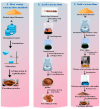Macroalgae Bioplastics: A Sustainable Shift to Mitigate the Ecological Impact of Petroleum-Based Plastics
- PMID: 38732716
- PMCID: PMC11085313
- DOI: 10.3390/polym16091246
Macroalgae Bioplastics: A Sustainable Shift to Mitigate the Ecological Impact of Petroleum-Based Plastics
Abstract
The surge in global utilization of petroleum-based plastics, which notably heightened during the COVID-19 pandemic, has substantially increased its harm to ecosystems. Considering the escalating environmental impact, a pivotal shift towards bioplastics usage is imperative. Exploring and implementing bioplastics as a viable alternative could mitigate the ecological burden posed by traditional plastics. Macroalgae is a potential feedstock for the production of bioplastics due to its abundance, fast growth, and high cellulose and sugar content. Researchers have recently explored various methods for extracting and converting macroalgae into bioplastic. Some of the key challenges in the production of macroalgae bioplastics are the high costs of large-scale production and the need to optimize the extraction and conversion processes to obtain high-quality bioplastics. However, the potential benefits of using macroalgae for bioplastic production include reducing plastic waste and greenhouse gas emissions, using healthier materials in various life practices, and developing a promising area for future research and development. Also, bioplastic provides job opportunities in free enterprise and contributes to various applications such as packaging, medical devices, electronics, textiles, and cosmetics. The presented review aims to discuss the problem of petroleum-based plastic, bioplastic extraction from macroalgae, bioplastic properties, biodegradability, its various applications, and its production challenges.
Keywords: applications; biodegradability; bioplastic; ecological impact; macroalgae; petroleum-based plastics.
Conflict of interest statement
The authors declare no conflicts of interest.
Figures











References
-
- Bishop G., Styles D., Lens P.N.L. Environmental Performance Comparison of Bioplastics and Petrochemical Plastics: A Review of Life Cycle Assessment (LCA) Methodological Decisions. Resour. Conserv. Recycl. 2021;168:105451. doi: 10.1016/j.resconrec.2021.105451. - DOI
-
- Shah M., Rajhans S., Himanshu A.P., Archana U. Mankad Bioplastic for Future: A Review Then and Now. World J. Adv. Res. Rev. 2021;9:056–067. doi: 10.30574/wjarr.2021.9.2.0054. - DOI
Publication types
LinkOut - more resources
Full Text Sources

